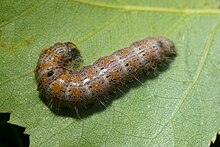Little moth
| Little moth | ||||||||||||
|---|---|---|---|---|---|---|---|---|---|---|---|---|

Little moth ( Clostera pigra ) |
||||||||||||
| Systematics | ||||||||||||
|
||||||||||||
| Scientific name | ||||||||||||
| Clostera pigra | ||||||||||||
| ( Hufnagel , 1766) |
The little grouse ( Clostera pigra ), also called aspen moth , is a butterfly ( moth ) from the family of toothed moths (Notodontidae).
features
Imago
The moths reach a wingspan of 22 to 28 millimeters, making them the smallest tooth spinner species found in Europe. They are dark gray-brown to reddish-brown in color and have several narrow, light yellow transverse lines on the forewings. There is a large maroon spot on the wing tip. The hind wings are dark brown. The thorax is dense dark red-brown hair on the back. The tip of the abdomen consists of a divided anal tuft in the males. The antennae are short and combed twice. The comb teeth are longer in the male than in the female.
egg
The hemispherical egg is flat and red in color.
Caterpillar
The basic color of the caterpillars varies from light gray to black gray. They have yellowish or reddish, interrupted side stripes and flat, black elevations on the fourth and eleventh segments and also a thin yellowish-gray hair.
Doll
The doll is shiny red-brown and has a cremaster that is long, pointed and studded with thorns.
Synonyms
- Pygaera pigra
Occurrence
The animals are widespread and mostly common in Europe and eastwards continuously to East Asia , also in Morocco and Iran . In the Alps they can still be found at heights of over 2,000 meters. The species is found in dry and damp habitats, such as in moors , on streams and rivers, but also in heaths and as a successful cultural successor in parks and gardens.
Way of life
During the day, the moths sit in a resting position with their wings folded together just above the abdomen. The front legs are stretched out and the tip of the abdomen with the anal bush stretched up between the wings. They are nocturnal and can be attracted by artificial light sources . The females lay the eggs on the forage plant. During the day, the caterpillars hide between leaves that are spun together, pupate there in a whitish-gray web and hibernate. The caterpillars feed on the leaves of various poplar species ( Populus ), such as the aspen ( Populus tremula ) and willow ( Salix ). The moths fly in two generations per year from early April to mid-June and from late July to late August.
Danger
The species is not endangered.
credentials
Individual evidence
- ^ A b Walter Forster, Theodor A. Wohlfahrt: The butterflies of Central Europe. Volume 3: Weirdos and Swarmers. (Bombyces and Sphinges). Franckh'sche Verlagshandlung, Stuttgart 1960, DNB 456642196 .
- ↑ a b c Manfred Koch: We determine butterflies. Volume 2: Bears, Spinners, Swarmers and Drills in Germany. 2nd, expanded edition. Neumann, Radebeul / Berlin 1964, DNB 452481929 .
literature
- Manfred Koch : We determine butterflies. Volume 2: Bears, Spinners, Swarmers and Drills in Germany. 2nd, expanded edition. Neumann, Radebeul / Berlin 1964, DNB 452481929 .
- Walter Forster , Theodor A. Wohlfahrt : The butterflies of Central Europe. Volume 3: Weirdos and Swarmers. (Bombyces and Sphinges). Franckh'sche Verlagshandlung, Stuttgart 1960, DNB 456642196 .
Web links
- www.biopix.dk Imago
- www.schmetterling-raupe.de caterpillar
- www.funet.fi distribution
- Clostera pigra at Fauna Europaea
